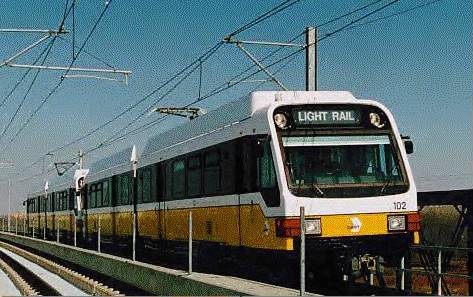
Light Rail Now and Walkable Neighborhoods (LRN) can be contacted at: Light Rail Now! |
Dallas: Light Rail Fuels Anti-Sprawl Urban Boom in Suburbs Introduction by Light Rail Progress The following article from the 'Dallas Morning News' underscores what rail transit proponents have been asserting for decades: that rail transit attracts clusters of development, helping to attenuate sprawl, and build in ridership around the rail transit stations.
As we've previously noted, this "clustering" process around light rail stations has a number of impacts highly beneficial to the livability and viability of urban areas. For example, by attracting development that would otherwise almost surely be sited in far-flung parts of the urban area (e.g., near outlying freeways or arterials), sprawl is averted. Furthermore, developing activity centers (and residential concentrations) near rail stations builds in ridership – most of it within easy walking or biking distance to the stations. Thus, there's a greater likelihood of trips being made on transit by people living near the stations and/or traveling to the nearby activity centers. And such clustered development tends to raise the tax base (by increasing land and property values). Once again, this Dallas-area experience resoundingly corroborates the light rail maxim: "Build it, and they will come." Dallas Morning News 08/15/2000 Getting a head start on DART Cities to develop areas near stations By Tony Hartzel / The Dallas Morning News Light-rail trains won't reach Farmers Branch until 2008, but officials there and in other cities are eagerly awaiting and planning for mass transit's impact. Following Saturday's successful DART bond election to speed light-rail construction, local leaders turned to their ideas for commercial and real estate development around planned rail stations. Proposed project plans could change the way at least some area residents live and work. "We've been pushing for this from day one," Farmers Branch Mayor Bob Phelps said. "We've had a master plan for that area for years. Dallas Area Rapid Transit is part of it and will enhance it." More than 1,100 apartments and lofts have been built around two current DART rail stations at Mockingbird Lane and at the old Sears building south of downtown. Restaurants, shops, theaters and a major entertainment venue also are planned or under construction. That type of development – where North Texans can live, shop and work nearby without having to rely on a car – should soon extend to places such as Richardson and Plano and then on to irving and Farmers Branch. Farmers Branch, which has spent several million dollars to buy property in its old downtown, plans to sell some parcels to a developer to build 300 to 500 condominium units. irving leaders, who earlier this year convinced DART to extend a rail line through Las Colinas, expect similar impacts. With more people choosing to live closer to central Dallas and near rail lines, some of the pressure eases for booming suburban areas in Denton and Collin counties, for example, said Michael Morris, the transportation director for the North Central Texas Council of Governments. On Saturday, 77 percent of voters supported DART's request to use $2.9 billion in long-term financing. As a result, 53 more miles of light rail should be built by 2013 and will arrive years earlier than if the transit agency had relied on shorter-term financing.
"It was slowly happening in California, but it was starting," said Mr. Snoble, the former head of the San Diego transit authority and a student of land-use policy. "I never thought I would see it in Texas, but it's happening more than in any other place in the nation." In Richardson, for example, the city is building a performing arts center near a major conference hall and hotel. In addition, residential units are being discussed for the site, near the future Campbell Road light-rail station. When rail opens, Mr. Phelps said, the Farmers Branch downtown that had its heyday in the 1950s should see a renaissance. Condominiums, a small shopping center or mall and other development should rejuvenate a three-block area, he said. "We're not trying to make big bucks. We want the development," the mayor said. "I was one of DART's critics when they started because I thought they were wasting money. They've got their act together, and they're doing good." People who choose not to live near rail stations should also see benefits. Taking cars off the road leaves at least a little more room for others, Mr. Snoble noted. "This gives people an option they just didn't have before."
|
|
|
|